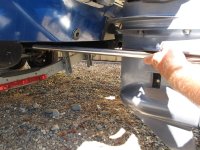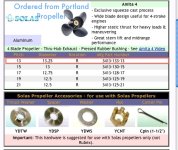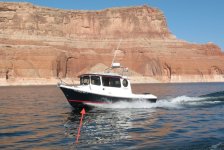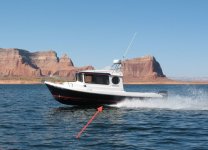I hope you can all put up with one more thread on this topic. But although I get the general concept (and have read through the archives), I'm still not sure what to change (prop-wise) on my individual boat, and I would appreciate any suggestions as to where to go, prop-wise.
So, first what I have now, and then some background to fill in more details:
Yesterday I went out for the first time in my "refit" boat. This being a 22 Cruiser, with Yamaha F80 main and Honda 8D kicker. The main has a Permatrim, and I have Bennett M-120 trim tabs. We were fairly heavily loaded, with about 15 gallons of water and 40 gallons of fuel, plus enough food for a couple of weeks or more, most of the tools I would ever have aboard, other usual gear, and two people (combined weight of about 400#). We were in fresh water at around 400' above sea level. Conditions were calm and smooth. Prop is a new Solas aluminum 4-bladed, 13 pitch x 13.25" diameter. (skip down a couple of paragraphs for comparative info). The bottom is gelcoat, although I waxed it recently (which I realize will slow it down slightly, but I did it for easier scrubbing of growth/slime).
Running at WOT, I was able to make around 5400 RPM and 20mph (currently have things set on statute miles as that is how it was for initial trial at purchase). It didn't seem to change a lot with various adjustments, but this was with engine trimmed fairly neutrally and maybe 30% tabs or so. I tried for getting the "spray trail" as far aft as possible looking out the side window.
My engine manual recommends a range of 5,000 - 6,000 RPM at WOT, so I'm within that range, but I would rather be closer to the upper end. Also in my mind is that I'm about to head to Powell, and so things can only get "worse" there. I wonder if I should get another prop - could be a spare/Powell prop.
Some background:
When I sea-trialed the boat briefly at purchase, things were a bit different. The boat was very light (no fuel, 15 gallons water, no gear, two people combined around 280#). At that point I had no Permatrim, no tabs, and the prop that came on the boat, which was a 3-bladed aluminum Michigan Wheel, 15 pitch x 13.5" diameter. We made 5600 RPM and 28 mph at that time. This was on a freshwater lake at about sea level, a very light chop and wind.
So, in a nutshell:
Then
Light boat
Sea level
3-bladed 15 x 13.5" aluminum prop
No Permatrim or tabs
5600 RPM/28 mph
Now
Heavyish boat
400' altitude
4-bladed 13 x 13.25" aluminum prop
Permatrim and tabs
5400 RPM/20 mph
I consulted with someone more experienced than me to choose the prop, and I'm guessing that with the original prop things would have been much worse, but I still think I'd like it better for sea level running, which would make it "less worse" on Powell too (which I'm about to leave for). I'm fine with getting another prop, but just not sure what to get, either in number of blades or other dimensions. Can someone make a suggestion?
*****************
The other factor I wonder about is engine height. Roy & Dixie from C-Way have a 22 that's three years older than mine, but with the same engine and from the same dealer. They found that their engine was set too low on the transom, and moved it up around 1-1/2" as a result. I'm not positive, but I think mine is about 1" higher than theirs was. Ultimately it just matters how it is on my boat, but their findings did raise the question in my mind about that dealer maybe setting engines too low.
From what I have read in the archives, a first, "loose" check is to see if the bottom of the anti-ventilation plate is level with the bottom of the boat. Mine is an inch or so lower than that, I think (I wasn't sure exactly how to angle the engine vis-a-vis the bottom or the transom; I guess the gap would be smaller if I had raised the engine to make them more parallel). You can see it here:

I also read that a more precise way is to see that the Permatrim rides just at or under the surface of the water when up on plane. I tried to ascertain that yesterday, but there is a lot of turbulence back there when on plane (is this normal?) so it was hard to tell. Maybe it's easy to tell when it is at the proper height and can be seen? Or does one always sort of "extrapolate" through the spray?

If the engine is too low, I imagine that is the thing to correct first. On the other hand, I'm not sure I would do that before Powell, and so I still think maybe I would rather order a prop now that might help. If I later move the engine up, it seems it would still be useful to have a "gradient" of props for different loads/altitudes, and they can be spares as well. If I can get one ordered tomorrow, I should be able to receive it and put it on before Powell. I'm hoping to spend a few weeks there and don't like the thought of lugging my engine that whole time.
Thanks,
Sunbeam
So, first what I have now, and then some background to fill in more details:
Yesterday I went out for the first time in my "refit" boat. This being a 22 Cruiser, with Yamaha F80 main and Honda 8D kicker. The main has a Permatrim, and I have Bennett M-120 trim tabs. We were fairly heavily loaded, with about 15 gallons of water and 40 gallons of fuel, plus enough food for a couple of weeks or more, most of the tools I would ever have aboard, other usual gear, and two people (combined weight of about 400#). We were in fresh water at around 400' above sea level. Conditions were calm and smooth. Prop is a new Solas aluminum 4-bladed, 13 pitch x 13.25" diameter. (skip down a couple of paragraphs for comparative info). The bottom is gelcoat, although I waxed it recently (which I realize will slow it down slightly, but I did it for easier scrubbing of growth/slime).
Running at WOT, I was able to make around 5400 RPM and 20mph (currently have things set on statute miles as that is how it was for initial trial at purchase). It didn't seem to change a lot with various adjustments, but this was with engine trimmed fairly neutrally and maybe 30% tabs or so. I tried for getting the "spray trail" as far aft as possible looking out the side window.
My engine manual recommends a range of 5,000 - 6,000 RPM at WOT, so I'm within that range, but I would rather be closer to the upper end. Also in my mind is that I'm about to head to Powell, and so things can only get "worse" there. I wonder if I should get another prop - could be a spare/Powell prop.
Some background:
When I sea-trialed the boat briefly at purchase, things were a bit different. The boat was very light (no fuel, 15 gallons water, no gear, two people combined around 280#). At that point I had no Permatrim, no tabs, and the prop that came on the boat, which was a 3-bladed aluminum Michigan Wheel, 15 pitch x 13.5" diameter. We made 5600 RPM and 28 mph at that time. This was on a freshwater lake at about sea level, a very light chop and wind.
So, in a nutshell:
Then
Light boat
Sea level
3-bladed 15 x 13.5" aluminum prop
No Permatrim or tabs
5600 RPM/28 mph
Now
Heavyish boat
400' altitude
4-bladed 13 x 13.25" aluminum prop
Permatrim and tabs
5400 RPM/20 mph
I consulted with someone more experienced than me to choose the prop, and I'm guessing that with the original prop things would have been much worse, but I still think I'd like it better for sea level running, which would make it "less worse" on Powell too (which I'm about to leave for). I'm fine with getting another prop, but just not sure what to get, either in number of blades or other dimensions. Can someone make a suggestion?
*****************
The other factor I wonder about is engine height. Roy & Dixie from C-Way have a 22 that's three years older than mine, but with the same engine and from the same dealer. They found that their engine was set too low on the transom, and moved it up around 1-1/2" as a result. I'm not positive, but I think mine is about 1" higher than theirs was. Ultimately it just matters how it is on my boat, but their findings did raise the question in my mind about that dealer maybe setting engines too low.
From what I have read in the archives, a first, "loose" check is to see if the bottom of the anti-ventilation plate is level with the bottom of the boat. Mine is an inch or so lower than that, I think (I wasn't sure exactly how to angle the engine vis-a-vis the bottom or the transom; I guess the gap would be smaller if I had raised the engine to make them more parallel). You can see it here:

I also read that a more precise way is to see that the Permatrim rides just at or under the surface of the water when up on plane. I tried to ascertain that yesterday, but there is a lot of turbulence back there when on plane (is this normal?) so it was hard to tell. Maybe it's easy to tell when it is at the proper height and can be seen? Or does one always sort of "extrapolate" through the spray?

If the engine is too low, I imagine that is the thing to correct first. On the other hand, I'm not sure I would do that before Powell, and so I still think maybe I would rather order a prop now that might help. If I later move the engine up, it seems it would still be useful to have a "gradient" of props for different loads/altitudes, and they can be spares as well. If I can get one ordered tomorrow, I should be able to receive it and put it on before Powell. I'm hoping to spend a few weeks there and don't like the thought of lugging my engine that whole time.
Thanks,
Sunbeam






